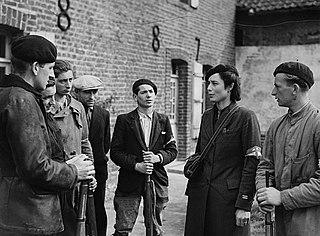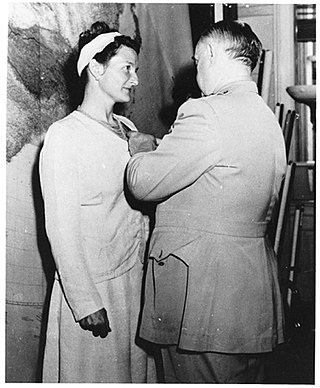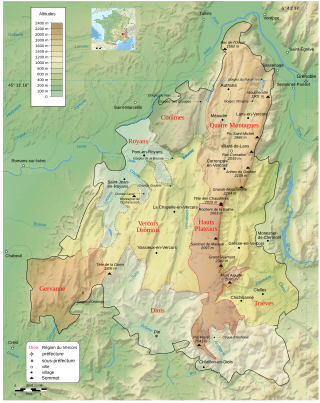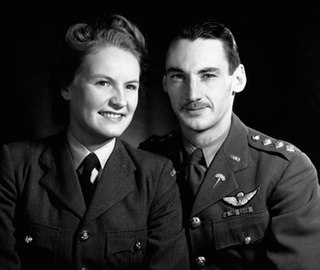
The Maquis were rural guerrilla bands of French and Belgian Resistance fighters, called maquisards, during the Nazi occupation of France in World War II. Initially, they were composed of young, mostly working-class, men who had escaped into the mountains and woods to avoid conscription into Vichy France's Service du travail obligatoire which provided forced labor for Germany. To avoid capture and deportation to Germany, they became increasingly organized into active resistance groups.

The French Resistance was a collection of organizations that fought the Nazi occupation of France and the collaborationist Vichy régime during the Second World War. Resistance cells were small groups of armed men and women who conducted guerrilla warfare and published underground newspapers. They also provided first-hand intelligence information, and escape networks that helped Allied soldiers and airmen trapped behind enemy lines. The Resistance's men and women came from many different parts of French society, including émigrés, academics, students, aristocrats, conservative Roman Catholics, Protestants, Jews, Muslims, liberals, anarchists, communists, and some fascists. The number of French people participating in the organized resistance is estimated at from one to three percent of the total population.

Nancy Grace Augusta Wake,, also known as Madame Fiocca and Nancy Fiocca, was a nurse and journalist who joined the French Resistance and later the Special Operations Executive (SOE) during World War II, and briefly pursued a post-war career as an intelligence officer in the Air Ministry. The official historian of the SOE, M. R. D. Foot, said that "her irrepressible, infectious, high spirits were a joy to everyone who worked with her". Many stories about her World War II activities come from her autobiography, The White Mouse, and are not verifiable from other sources.
The SOE F Section timeline lists the significant events in the history of Section F of the Special Operations Executive. The Special Operations Executive (SOE) was a clandestine organization of the United Kingdom during World War II. The purpose of SOE was to conduct espionage, sabotage, and reconnaissance in countries occupied by the Axis powers. SOE agents allied themselves with resistance groups and supplied them with weapons and equipment parachuted in from England. Section F was responsible for many of SOE's activities in France which was occupied by Nazi Germany.

Virginia Hall Goillot DSC, Croix de Guerre,, code named Marie and Diane, was an American who worked with the United Kingdom's clandestine Special Operations Executive (SOE) and the American Office of Strategic Services (OSS) in France during World War II. The objective of SOE and OSS was to conduct espionage, sabotage and reconnaissance in occupied Europe against the Axis powers, especially Nazi Germany. SOE and OSS agents in France allied themselves with resistance groups and supplied them with weapons and equipment parachuted in from England. After World War II Hall worked for the Special Activities Division of the Central Intelligence Agency (CIA).

Cecile Pearl Witherington Cornioley,, code names Marie and Pauline, was an agent in France for the United Kingdom's clandestine Special Operations Executive (SOE) during the Second World War. The purpose of SOE was to conduct espionage, sabotage, and reconnaissance in occupied Europe against the Axis powers. SOE agents allied themselves with French Resistance groups and supplied them with weapons and equipment parachuted in from England.

Charlotte Gray is a 1999 novel by Sebastian Faulks. Faulks completes his loose trilogy of books about France with this story of the adventures of a young Scotswoman, Charlotte Gray, who becomes an agent of Britain's Special Operations Executive (SOE) assigned to work with the French Resistance in Vichy France, during World War II. Although denied by the author, the story and title character have been compared to the exploits of SOE agents Nancy Wake and Pearl Witherington.

The Battle of Vercors in July and August 1944 was between a rural group of the French Forces of the Interior (FFI) [maquis] and the armed forces of Nazi Germany which had occupied France since 1940 in the Second World War. The maquis used the prominent scenic plateau known as the Massif du Vercors as a refuge. Initially, the maquis carried out only sabotage and partisan operations against the Germans. However, after the Normandy Invasion of 6 June 1944, the leadership of an army of about 4,000 maquis declared the Free Republic of Vercors and attempted to create a conventional army to oppose the German occupation.

Sir Louis Pierre Rene "Amédée" Maingard de la Ville-ès-Offrans, CBE was born in Mauritius, then a British colony. During the Second World War, he served with distinction with the British clandestine organization, the Special Operations Executive, supporting the French resistance, and was awarded medals by the British and French governments. After the war he returned to Mauritius and became a successful businessman.

Anterrieux is a commune in the Cantal department in the Auvergne region of southern central France.

Sonya Esmée Florence Butt, also known as Sonia d'Artois, code named Blanche, was an agent of the clandestine Special Operations Executive during the Second World War. SOE agents allied themselves with groups resisting the occupation of their countries by Axis powers. The purpose of SOE was to conduct espionage, sabotage, and reconnaissance in occupied countries. The SOE supplied resistance groups with weapons and equipment parachuted in from England.

Richard Henry Heslop, DSO, code named Xavier, was an agent in France of the United Kingdom's clandestine Special Operations Executive (SOE) organization during World War II. The purpose of SOE was to conduct espionage, sabotage, and reconnaissance in countries occupied by Nazi Germany or other Axis powers. SOE agents allied themselves with resistance groups and supplied them with weapons and equipment parachuted in from England.

Lt. Col Frederick Henry Cardozo MC was a British soldier and SOE veteran. Cardozo was brought up in the Loire Valley between 1923 and 1933.
Maurice Southgate, code named Hector, was an officer in the Royal Air Force and an agent of the United Kingdom's clandestine Special Operations Executive (SOE) organization during World War II. The purpose of SOE was to conduct espionage, sabotage, and reconnaissance in occupied Europe against the Axis powers, especially Nazi Germany. SOE agents allied themselves with resistance groups and supplied them with weapons and equipment parachuted in from England.

Émile Coulaudon, known as Colonel Gaspard, was one of the principal leaders of the French Resistance in Auvergne during the Second World War.
Adrien Pommier was a member of the French Resistance during World War II.

Major Desmond Evelyn Longe, MC, DL, was a British Army Major, S.O.E agent and Commander of the Inter-Allied mission, Eucalyptus.
Prometheus II was a minor group of the Greek Resistance during the Axis occupation of Greece in World War II, engaged in espionage and sabotage operations in collaboration with the Special Operations Executive, as well as providing liaison to other groups of the Resistance.
Odette Victoria Wilen was a member of the UK's Special Operations Executive (SOE) during World War II. She served in occupied France under the code name "Sophie".














